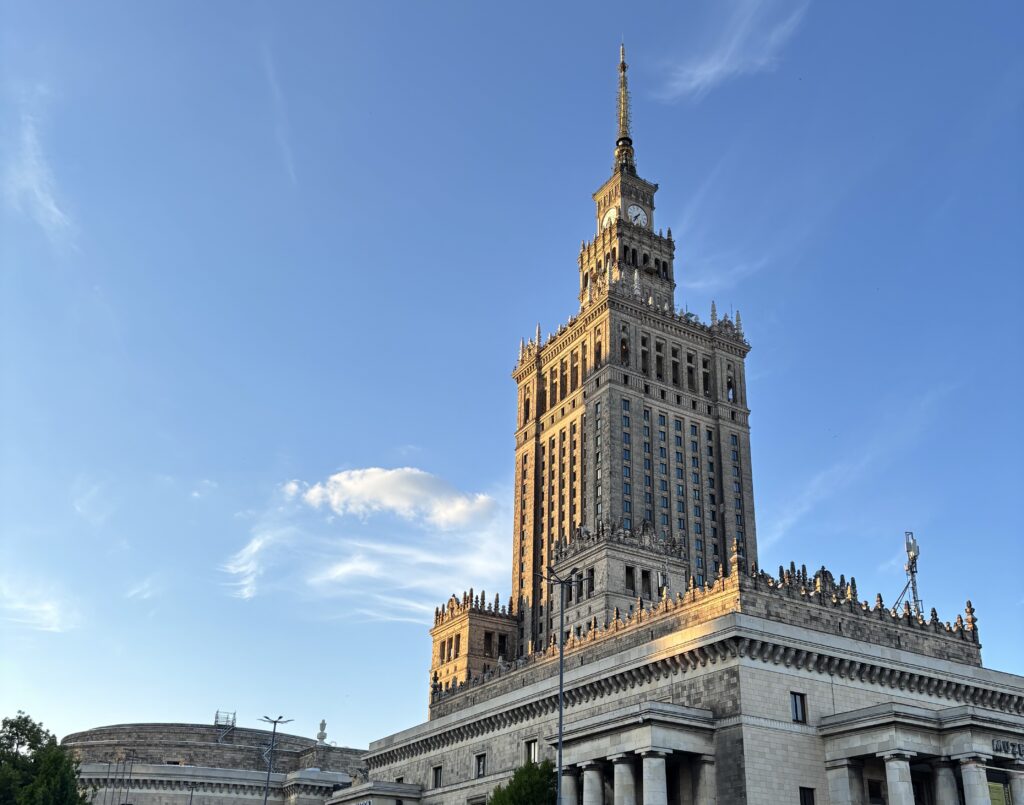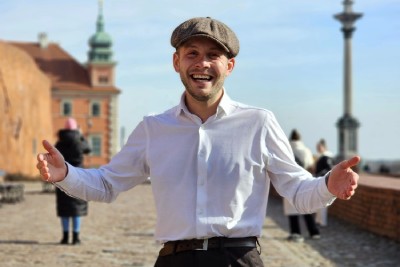- A gift from Stalin — a present that came with strings
- Landmarks in Warsaw — The PRL-era ones deserve attention too
- Warsaw with a guide — PKiN and the traces of communism
- City tours in Warsaw — better with a guide
- With a local guide, you’ll see more
The Palace of Culture and Science in Warsaw is one of the most recognizable buildings in Poland — and undoubtedly one of those attractions in Warsaw that no one passes by indifferently. Some love it, others… not so much. But regardless of opinion — it is PKiN (Palac Kultury i Nauki – Palace of Culture and science), as Varsovians call it, that became a symbol of a city rebuilt from ruins and at the same time a difficult chapter in Polish history.
A gift from Stalin — a present that came with strings
The history of the Palace of Culture and Science began in the 1950s, when Warsaw was still healing from World War II. In 1952, the Soviet Union “gifted” the Polish people a monumental building meant to symbolize Polish-Soviet friendship. For residents, this meant several years of construction that changed the city skyline forever.
Construction lasted from 1952 to 1955. The design was modeled on Soviet skyscrapers — the so-called Stalinist Seven Sisters in Moscow. But Warsaw’s palace was to be unique — more representative, full of decorative details usually absent in socialist realist monoliths.

Landmarks in Warsaw — the PRL-era ones deserve attention too
Today, PKiN (Palac Kultury i Nauki – Palace of Culture and science) is no longer the tallest building in Poland. It stands 237 meters tall, while the Varso Tower reaches 310 meters. Still, PKiN (Palac Kultury i Nauki – Palace of Culture and science) remains one of the most controversial landmarks in Warsaw. The grim gray socialist realist building houses theaters, museums, a cinema, cafés, offices, and the famous observation deck — offering a view of the entire city from a completely different perspective.
For tourists, it’s a must-see stop — especially for those interested in Warsaw landmarks in English, as the Palace’s story is the perfect introduction to discussions about life in communist Poland.
Warsaw with a guide — PKiN and the traces of communism
A tour of the Palace itself is one thing, but the real adventure begins when you set off on the “Communism in Warsaw” route with a local guide in Warsaw. Why? Because the Palace of Culture is only the beginning. Surrounding it is an entire world of communist-era architecture: monumental ministry buildings, the socialist realist MDM housing estate, Constitution Square, the Forum Hotel, and many other symbolic places tied to censorship and May Day parades.
With a tour guide in Warsaw, you’ll learn what everyday life in the capital was like — where people bought scarce goods and where they could watch banned films. It’s a journey through stories you won’t find in just any guidebook at a newsstand.

City tours in Warsaw — better with a guide
You can ride up to the observation deck, take a look around, snap a selfie, and forget you were ever there. But if you want to understand why the Palace was built, how it has changed over the years, and why Varsovians have such a turbulent relationship with it — choose a guided tour of Warsaw.
For international visitors, guided tours of Warsaw in English are an excellent choice. The story of communism becomes a fascinating history lesson — with context, photos, and anecdotes you won’t read in a paper guidebook.
With a local guide, you’ll see more
Warsaw has many faces — royal, modern, and socialist realist. Exploring Warsaw with a guide is the best way to get to know and understand them all. A certified tour guide in Warsaw offers more than just facts about the cornerstone ceremony. They tell the stories of people who worked here, protested here, and dreamed of better times.
